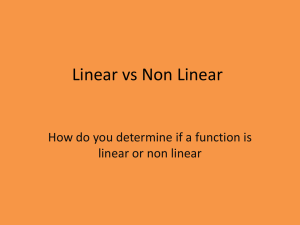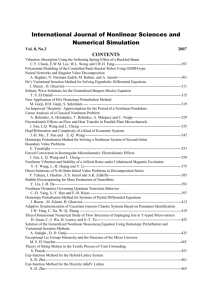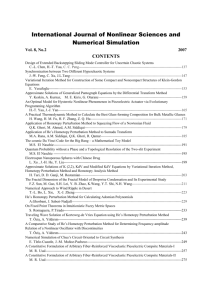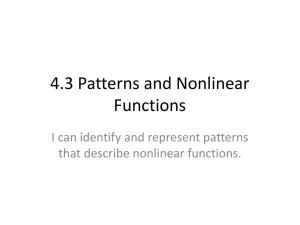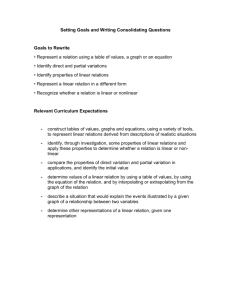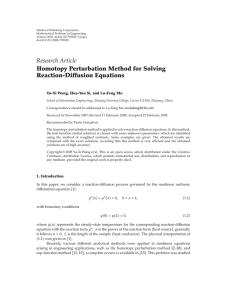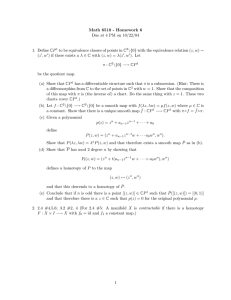Document 12062111
advertisement
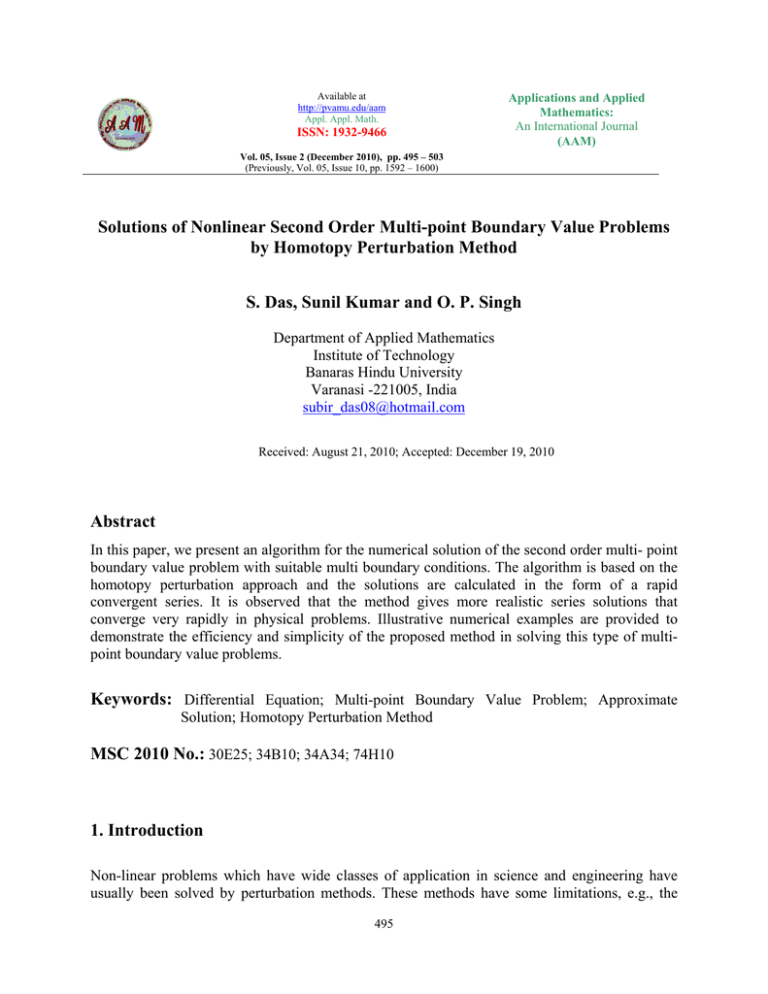
Available at http://pvamu.edu/aam Appl. Appl. Math. ISSN: 1932-9466 Applications and Applied Mathematics: An International Journal (AAM) Vol. 05, Issue 2 (December 2010), pp. 495 – 503 (Previously, Vol. 05, Issue 10, pp. 1592 – 1600) Solutions of Nonlinear Second Order Multi-point Boundary Value Problems by Homotopy Perturbation Method S. Das, Sunil Kumar and O. P. Singh Department of Applied Mathematics Institute of Technology Banaras Hindu University Varanasi -221005, India subir_das08@hotmail.com Received: August 21, 2010; Accepted: December 19, 2010 Abstract In this paper, we present an algorithm for the numerical solution of the second order multi- point boundary value problem with suitable multi boundary conditions. The algorithm is based on the homotopy perturbation approach and the solutions are calculated in the form of a rapid convergent series. It is observed that the method gives more realistic series solutions that converge very rapidly in physical problems. Illustrative numerical examples are provided to demonstrate the efficiency and simplicity of the proposed method in solving this type of multipoint boundary value problems. Keywords: Differential Equation; Multi-point Boundary Value Problem; Approximate Solution; Homotopy Perturbation Method MSC 2010 No.: 30E25; 34B10; 34A34; 74H10 1. Introduction Non-linear problems which have wide classes of application in science and engineering have usually been solved by perturbation methods. These methods have some limitations, e.g., the 495 496 S. Das et al. approximate solution involves a series of small parameters which poses difficulty since the majority of nonlinear problems have no small parameters at all. Although appropriate choices of small parameters do lead to ideal solution while in most other cases, unsuitable choices lead to serious effects in the solutions. The homotopy perturbation method (HPM) employed here, is a new approach for finding the approximate solution that does not require small parameters, thus overcoming the limitations of the traditional perturbation techniques. The method was first proposed by He (1999) and successfully applied by other researchers like He (2000, 2005) boundary value problems by He (2006), in integro differential equation by El-Shahed (2005) , in non-Newtonian flow by Siddiqui et al. (2006), in linear PDEs of fractional order by Monami and Odibat (2007), Darvishi and Khani (2008), Belendez and Alvarez (2008), Mousa and Ragab (2008), Das and Gupta (2009) etc discussed the method to solve various linear and nonlinear problems. The existence of positive solutions for multi-point boundary value problems (BVP) is one of the key areas of research these days owing to its wide application in engineering like in the modelling of physical problems involving vibrations occurring in a wire of uniform cross section and composed of material with different densities, in the theory of elastic stability and also its applications in fluid flow through porous media. The nonlocal multipoint problems are mainly restricted to second order equations. In 2004, Agarwal and Kinguradze (2004) solved linear ordinary differential equations of higher order with singularities at several points. The existence of a solution for quasi-linear and resonance cases is discussed in the article of Cheung and Ren (2005) and Lin and Liu (2009). In 2006, Tatari and Dehghan (2006) used another mathematical tool the Adomian decomposition method (ADM) to obtain an approximate solution of multi-point BVP. [To the best of authors’ knowledge the solution of multi-point BVP, using only the HPM is yet to be found]. In this, article the efficient mathematical tool HPM is used to solve the nonlinear second order multipoint BVP u ( x ) g (u , u ) f ( x ), 0 x 1, m u ( 0 ) , u ( 1 ) i u ( i ) , i 1 (1) where i (0,1), i 0,1,2,3,...m, and are constants. The problem (1) was recently solved by Geng and Cui (2009) in a rather complicated manner by combining the HPM and variational iteration method (VIM). The elegance of this paper lies in the simplicity of the solution, using only the HPM. Three examples are solved which show that only a few iterations are needed to obtain accurate approximate solutions. The error analysis represented graphically demonstrates the high reliability of the proposed method. AAM: Intern. J., Vol. 05, Issue 2 (December 2010) [Previously, Vol. 05, Issue 10, pp. 1592 – 1600] 497 2. Method of Solution According to the HPM, we construct the following homotopy of equation (1) as H(v, p) u(x) f (x) p g(u, u) 0, (2) where p [0,1] is an embedding parameter. Now by applying the classical perturbation technique, we assume that the solution of the equation (2) can be expressed as a power series in p as u ( x ) u 0 ( x ) pu 1 ( x ) p 2 u 2 ( x ) p 3 u 3 ( x ) .... (3) where, un ( x), n 0,1,2,3,.. is the function to be determined by the following iterative scheme. When p 1 , equation (3) becomes the approximate solution of equation (1). Substituting equation (3) in equation (2) and equating the like powers of p , we obtain the following set of nonlinear differential equations: u 0 x f ( x ) 0, m p : i u 0 i , u 0 0 , u 0 1 i 1 (4) u1 x g (u , u ) p 0 0, m p1 : u1 0 0, u1 1 i u1 i , i 1 (5) g ( u , u ) 0, u 2 x dp p 0 p2 : m u 0 0 , u 1 i u 2 i , 2 2 i 1 (6) 2 g ( u , u ) 0, u x 3 dp 2 3 p 0 p : m u 3 0 0, u 3 1 i u 3 i , i 1 (7) 0 ڭ 498 S. Das et al. n 1 g (u , u ) 0, u n x dp n 1 n p 0 p : m u 0 0, u 1 iun i . n n i 1 (8) The above nonlinear equations can be easily solved and the components u n ( x ) can be completely determined, thus enabling the series solution to be entirely determined. Finally, the approximate solution for u (x ) is obtained by truncating the series u ( x ) lim N ( x ), N (9) where N ( x) N 1 u n0 n ( x) . 3. Numerical Examples In this section, to demonstrate the effectiveness of the HPM algorithm, four examples of the nonlinear systems are discussed. Example 1: Consider the Nonlinear multi-point boundary value problem '' x 2 (1 x) ( ) u x u ( x) u 2 ( x) f ( x), 2 4 u (0) 0, u (1) 1 u i 0.708667, i 0 1 i 5 with exact solution u ( x) x 2 , when f ( x) x 3 2. Here, applying the same method as the previous section, the ui ( x), i 0,1,2,... are calculated as u 0 ( x ) x 2 0.099794 x 0.05 x 5 , u1 ( x ) 0.0821x 0.00333 x 4 0.04252 x 5 0.002054 x 8 0.00035 x 9 0.000019 x12 , AAM: Intern. J., Vol. 05, Issue 2 (December 2010) [Previously, Vol. 05, Issue 10, pp. 1592 – 1600] 499 u 2 ( x) 0.01365 x 0.002055 x 4 - 0.00616x 5 - 0.000143 9x 7 0.0016 x 8 0.0003 x 9 0.000068 x11 - 0.00001x 12 0.000006 x13 0.0000015 x15 0.00000046 x16 0.0000000055 4 x19 , u3 ( x) 0.003025x - 0.0009x 4 - 0.0010237x 5 0.000075x 7 0.00035x 8 - 0.000043x 9 0.000005 x10 - 0.00005 x11 0.000025 x12 0.0000047 x13 0.0000018 x14 0.00000018 x15 0.00000007 x16 0.00000009 x17 0.00000007 x18 0.00000004 x19 0.000000009 x 20 0.0000000006 x 22 0.0000000002 x 23 0.0000000000 014 x 26 , In the same manner, the rest of components can be obtained. Finally we get the approximate solution from equation (9), taking six terms of the series solutions. The series solution converges very rapidly. The rapid convergence means only few terms are required to get the approximate solution. E(x) 1. 10 6 8. 10 7 6. 10 7 4. 10 7 2. 10 7 0.2 0.4 0.6 0.8 1.0 x Figure 1. Plot of absolute error E (x ) vs. x for Example 1 Example 2. Now we consider the following nonlinear multi-point boundary value problem u '' ( x) x u ( x) u ( x) 2u 2 ( x) f ( x), 4 1 i ( 0 ) 0 , ( 1 ) u u u 0.252, i 0 1 i 5 with exact solution u ( x) x( x 1), when f ( x) x 3 x 2 2. Proceeding as in the previous section, the values of ui ( x), i 0,1,2,... are obtained as u0 ( x) 0.9399 x x 2 0.08333 x 4 0.05 x 5 , 500 S. Das et al. u1 ( x) 0.048923 x 0.07362 x 4 0.047 x 5 0.00187 x 7 0.00466 x 8 0.0021x 9 0.000154 x10 0.00019 x11 0.000057 x12 , u 2 ( x) - 0.004288x 0.00244613 x 5 0.0046508x 7 - 0.0082383x 8 0.00326346 x 9 0.00029211 9x 10 - 0.00008637 51x 11 - 0.00025835 9x12 0.00010285 9x13 0.00004469 5x 14 - 0.00003400 23x15 0.0000074 x 16 0.000001123 x17 0.00000065 x18 0.000000125 x19 , u3 ( x) - 0.00118096 x 0.00087112 7x 4 - 0.00021439 3x 5 0.0000772 3 96x 7 0.0000077 x 8 - 0.00010192 2x 9 0.00006979 7x 10 - 0.00038649 x 11 0.0004535x 12 - 0.0001109 0 6x 13 - 0.00007531 32x 14 0.00003843 x 15 0.00000533 x16 0.00000385 x17 0.00000375 x18 0.00000263 x19 0.000000327 x 20 0.00000029 x 21 0.000000129 x 22 0.0000000164 x 23 0.000000004 4 7 x 24 0.0000000017 x 25 0.0000000002 4 x 26 , Similarly, the rest of the components are calculated and the approximate analytical solution of u(x) can be obtained from equation (9). E(x) 8. 10 7 6. 10 7 4. 10 7 2. 10 7 0.2 0.4 0.6 0.8 1.0 x Figure 2. Plot of absolute error E (x) vs. x for Example 2 Example 3. Here, we consider the nonlinear multi-point boundary value problem as u '' ( x) u ( x)u ( x) f ( x), 4 1 i u u u 0.3277, ( 0 ) 0 , ( 1 ) i 0 1 i 5 AAM: Intern. J., Vol. 05, Issue 2 (December 2010) [Previously, Vol. 05, Issue 10, pp. 1592 – 1600] 501 with exact solution u ( x) sin x, when f ( x) (cos x 1) sin x. In this case the values of ui ( x), i 0,1,2,... are calculated as u0 ( x) sin x 3e 2 x 1 cos x sin x 0.01165 x, 8 4 u1 ( x) 0.0086 x 0.000023 x 3 0.00073 x cos 2 x 0.051sin x cos(0.1165 0.251sin x) 0.02083 sin 3 x 0.00097 sin 4 x, Finally, the approximate analytical solution of the problem is obtained from equation (9). E(x) 0.00025 0.00020 0.00015 0.00010 0.00005 0.2 0.4 0.6 0.8 1.0 x Figure 3. Plot of absolute error E (x) vs. x for Example 3 4. Numerical Results and Discussion In this section, we discuss the implementation of our proposed algorithm and investigate the accuracy achieved by applying the homotopy perturbation method. The simplicity and accuracy of the proposed method is illustrated through numerical examples. The absolute error is computed E ( x ) | u exact ( x ) - u approx ( x ) | for all three examples, where u exact ( x ) is the exact solution and u approx ( x ) is an approximate solution of the problem. This was done by truncating the series ( 9 ). The errors E ( x ) for all the considered examples are depicted in Figures 1-3. In each case the error is increases with an increasing x , except when x is close to unity, when a decreasing tendency of the error is observed. The accuracy maybe improved by introducing more terms to the approximate solution. [Six iterations were performed in each case]. 502 S. Das et al. 5. Conclusion In this paper the powerful mathematical tool the HPM is successfully applied to solve the nonlinear multipoint BVPs. The three examples included aptly demonstrate the level of accuracy achieved in the approximation of the solutions. This method yields more realistic series solutions that converge rapidly to the exact solutions. The study shows that the method leads to quantitatively more reliable results with less computational work. Acknowledgement The authors of this article are extending their heartfelt thanks to the respected reviewers for their invaluable suggestions for the improvement of the paper. REFERENCES Agarwal, R. P. and Kinguradze, I. (2004). On multi-point boundary value problems for linear ordinary differential equations with singularities, J. Math. Anal. Appl. 297, 131-151. Belendez, A., Alvarez, M. L., Mendez, D. I., Fernandez, E., Yebra, M. S. and Belendez, T. (2008). Approximate Solutions for Conservative Nonlinear Oscillators by He's Homotopy Method, Z. Naturforsch., 63a, 529-537. Cheung, Wing-Sum and Ren, Jingli (2005). Twin positive solutions for quasi-linear multi-point boundary value problems, Nonlinear Analysis 62, 167-177. Darvishi, M. T., Khani, F., (2008). Application of He's Homotopy Perturbation Method to Stiff Systems of Ordinary Differential Equations, Z. Naturforsch., 63a, 19-23. Das, S. and Gupta, P. K. (2009). An approximate analytical solution of the fractional diffusion equation with absorbent term and external force by Homotopy Perturbation Method, Z. Naturforsch. A, Accepted. El-Shahed, M. (2005). Application of He’s homotopy perturbation method to Volterra’s integrodifferential equation, International Journal of Nonlinear Sciences and Numerical Simulation. 6, 163-168. Geng, F.Z. and Cui, M.G. (2009). Solving nonlinear multi-point boundary value problems by combining Homotopy perturbation and Variational Iteration Methods, Int. J. of Nonlin. Sci. Numer. Simul. 10, 597-600. He, J. H. (1999). Homotopy perturbation technique, Computer Methods in Applied Mechanics and Engineering. 178, 257-262. He, J. H. (2000). A coupling method of homotopy technique and perturbation technique for non linear problems, International Journal and Nonlinear Mechanics 35, 37-43. He, J. H. (2005). Application of homotopy perturbation method to nonlinear wave equations, Chaos, Solitons & Fractals. 26, 695-700. AAM: Intern. J., Vol. 05, Issue 2 (December 2010) [Previously, Vol. 05, Issue 10, pp. 1592 – 1600] 503 He, J. H. (2005). Periodic solutions and bifurcations of delay-differential equations, Physics Letters A. 347, 228-230. He, J. H. (2005). Homotopy Perturbation method for bifurcation of nonlinear problems, International Journal of Nonlinear Sciences and Numerical Simulation. 6, 207-208. He, J. H. (2005). Limit cycle and bifurcation of nonlinear problems, Chaos, Solitons & Fractals. 26, 827-833. He, J. H. (2006). Homotopy Perturbation method for solving boundary value problems, Physics Letters. A 350, 87-88. Lin, X. and Liu, W. (2009). A nonlinear third order multi-point boundary value problem in the resonance case, J. Appl. Math Comput. 29, 35-51. Momani, S. and Odibat, Z. (2007). Comparison between the HPM and the VIM for linear fractional partial differential equations. Comput. Math. Appl, 54, 910-919. Mousa, M. M. and Ragab, S. F. (2008). Application of the Homotopy Perturbation Method to Linear and Nonlinear Schrödinger Equations, Z. Fur Naturforsch. Sec., 63a, 140-144. Siddiqui, A. M., Mahmood, R. and Ghori, Q. K. (2006). Couette and Poiseuille flows for nonNewtonian fluids, International Journal of Nonlinear Sciences and Numerical Simulation. 7, 15-26. Siddiqui, A. M., Mahmood, R. and Ghori, Q. K. (2006). Thin film flow of a third grade fluid on a moving belt by He’s homotopy perturbation method, International Journal of Nonlinear Sciences and Numerical Simulation, 7, 7-14. Tatari, M. and Dehghan, M. (2006). The use of the Adomian decomposition method for solving multi-point boundary value problems, Phys. Scr. 73, 672-676.
